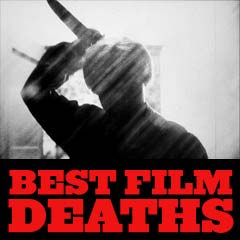
|
Deaths Scenes 1991 |

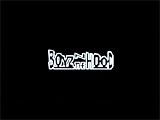
|
Boyz 'N the Hood (1991) Writer/director John Singleton's directorial debut film was a chronicle of the lives of three African-American males living in the mid-1980s to the early 1990s in the Crenshaw ghetto district of south central Los Angeles, known for violence, crime, drugs, and gang wars. Black football star Ricky Baker (Morris Chestnut) was shockingly killed with two gunblast shots from a red car during a drive-by shooting in a South Central LA alleyway, as best friend Tre Styles (Cuba Gooding, Jr.) watched in horror. The two had run from the car and scaled some neighborhood fences, but Ricky was left out in the open and attempted to run, but was caught in the gunfire. Adding to the tragedy was the fact that college-bound Ricky had just received his SAT scores in the mail that would have allowed him to attend USC with a scholarship. His friends took his blood-stained, lifeless corpse back to his house, where his girlfriend/wife Shanice (Alysia Rogers) with young child and mother Brenda (Tyra Ferrell) wailed over him. Tre was given the choice of avenging the death with others, but ultimately chose not to join them in the unending cycle of retribution. |
 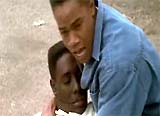 Ricky Baker's Drive-by Killing 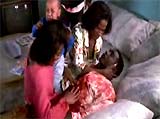 Dying in His Mother's and Girlfriend's Presence |
||||||||||||

|
Bugsy (1991) Director Barry Levinson's crime drama was a semi-fictional biopic of the psychopathic, larger-than-life, East Coast 40s gangster Benjamin 'Bugsy' Siegel (Oscar-nominated Warren Beatty). Bugsy was standing in his Beverly Hills home's living room in June of 1947, reading a newspaper and sentimentally watching a projected film reel of his own awful Hollywood screen test. Suddenly, a gunshot rang out - piercing through the outside window and into his chest. He was furthermore killed by over a dozen gun shots from an outside hitman/sniper (the last shot hit him in the right eye through the back of his skull). The 'death' scene was made to look artistically-composed, when some of the errant shots hit various objects in the room:
The screen went slowly black. [Note: In reality, Bugsy was not alone when murdered, nor watching a film. He was speaking to another gangster. The first shot hit him in the head, blowing out his eyeball from his face and landing 15 feet away. The killer was presumably hired by mobster associate Meyer Lansky (Ben Kingsley). Bugsy's over-budget $6 million "Flamingo" casino in the Nevada desert had just closed after a brief opening, but had then re-opened.] |
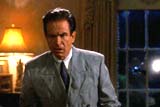 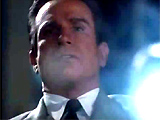 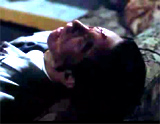 Murdered in His Own Beverly Hills Home |
||||||||||||
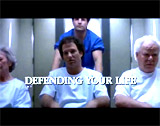
|
Defending Your Life (1991) Writer/director Albert Brooks fantasy romantic comedy was about life after death. It told about the fate of a man who bought a new black BMW convertible (a $39,000 gift to himself) on his 40th birthday. Successful, divorced yuppie LA advertising executive Daniel Miller (Albert Brooks) then promptly died in a car accident in the film's opening. He was distracted while listening to Barbra Streisand's rendition of "Something's Coming" from West Side Story (1961). When his birthday gifts (a pile of music CDs) from the office party fell to the floor of the car, he reached down to retrieve them. The distraction caused his car to swerve into the other lane of oncoming traffic and directly into a city bus. He screamed as he realized he was about to experience a fatal crash, but it was too late. In the next scene under the credits, he woke up and found himself in "Judgment City" in an other-worldly hospital, where most of the film then took place. There, he was beginning his afterlife while pushed in a wheelchair by heavenly attendants. He would have to defend his life's actions in a trial - and judged to determine whether he would be advancing to heaven or heading to hell. |
 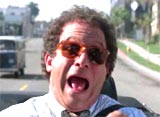 Distracted Driving Death 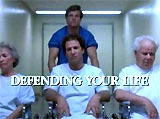
|
||||||||||||
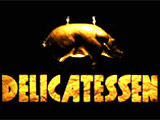
|
Delicatessen (1991, Fr.) Jean-Pierre Jeunet and Marc Caro's black comedy was set in a post-apocalyptic 1950s France (of the future), during a time of famine. Cannibalistic butcher/landlord Clapet (Jean-Claude Dreyfus), whose business was selling human flesh in a ground-floor delicatessen, inadvertently died in his own decaying tenement apartment building in the film's conclusion. He made an attempt to murder circus clown Louison (Dominique Pinon), one of his tenants, after luring him to work as a handyman in the apartment building. After he threw Louison's own sharp Australian knife-boomerang at him, it turned back and hit him square in the forehead. Clapet quizzically stumbled around before expiring, and asked:
|
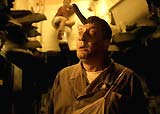 Boomeranged Knife into Clapet's Forehead |
||||||||||||
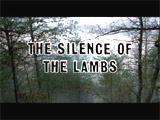
|
The Silence
of the Lambs (1991) Director Jonathan Demme's psychological thriller, a Best Picture winner, provided a shocking portrait of a mass murderer - intelligent psychiatrist-turned-psychopath Dr. Hannibal Lecter. The Shelby County Courthouse, a stronghold surrounded by police and reporters from the media, was the location of serial killer Dr. Hannibal Lecter's (Anthony Hopkins) imprisonment. In the middle of the Historical Society Room on the fifth floor, a massive temporary iron cage had been erected, cordoned off by black and white striped police barricades. Lecter listened to Bach's Goldberg Variations seated behind a thin toilet screen. As the two guards brought another meal on a tray, they complained about his ordering a second elegant dinner with "lamb chops, extra rare." As they prepared to enter, Lecter ejected a shiny silver metallic clip from Dr. Chilton's pen from his lips, hid it between his fingers, and dutifully slid down next to the bars to position himself for hand-cuffing. After securing Lecter's wrists, the guards entered the cell and placed the tray down, Lecter cleverly escaped from the cuffs and lunged at Sgt. Jim Pembry (Alex Coleman) with gruesome, face-eating cannibalism. He then smashed Pembry's skull into the bars and sprayed mace into his eyes.
During his vicious rampage, the second guard Sgt. Boyle (Charles Napier) was mercilessly beaten to death by the bloody-faced Lecter with a police riot baton. After the two brutal attacks, the camera panned over the blood-flecked food tray over to the cassette player, where Lecter was lost listening to Bach. His hand airily drifted over the player. In the background, seriously-wounded Pembry struggled to crawl away. Lecter found a four-inch pocketknife, spilled from Boyle's pockets, and warned the wounded man:
After hearing shots fired, officers found the bloody and savaged body of Sgt. Boyle strung up high on the cell bars like Christ, with a carved-away abdomen. "Sgt. Pembry," with an unrecognizable, gory face, lay bloodied on the floor, and Lecter appeared to be missing.
The near-dead officer Pembry, overwhelmed by a seizure, was whisked away to the elevator on a stretcher and put in an ambulance to be driven away; meanwhile, SWAT team members saw a distant figure dressed like Lecter lying bloodied atop the elevator and believed that Lecter was dead; but the clever Lecter had dressed himself up as Pembry with a bloodied and lacerated face, and then had fooled the officers by disguising himself as the victim Pembry in the ambulance in order to escape - and kill the paramedic. |
 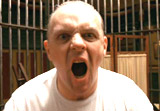 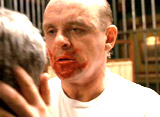 Sgt. Jim Pembry's Cannibalistic Demise by Hannibal Lecter 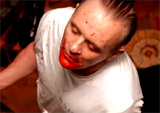 Lecter Relaxing and Listening to Bach 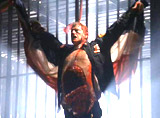 Results of Sgt. Boyle's Beating and 'Crucifixion' |
||||||||||||

|
The Silence of the Lambs (1991) In the film's climactic scene, FBI agent Clarice (Jodie Foster) pursued serial killer and madman Jamie Gumb (Buffalo Bill) (Ted Levine) inside the suspect's house. When she had held him at gunpoint and commanded him to "Freeze!", he evaded her, ducked into the kitchen, and disappeared into the cellar. During a terrifying chase sequence in the dungeon-like hideaway, she cautiously followed the madman down the stairwell into the cellar with her gun drawn. Swiveling from side to side with her gun for protection, she came upon a pit after hugging walls and closing off openings behind which Gumb could be lurking. She located the kidnapped, hysterical girl who could only cry: "Get me out of here!" When she promised that she would be back after continuing her hunt and stalking of Gumb, Catherine screamed: "Nooo! Don't you leave me here, you f--kin' bitch!...Please, I gotta get out of here!" Loudly, she replied: "THE OTHER OFFICERS WILL BE HERE ANY MINUTE NOW!" Gasping for breath and crouching as she wove back and forth in passageways lit by naked light bulbs, she found herself in Gumb's laboratory and skinning room, where big moths flew overhead, and a 'skin suit' was briefly seen on a dressmaker's dummy. In a bathroom off the workroom, a female hand and wrist extended up out of a murky mixture in a bathtub. As Clarice reacted in horror to the sight, the lights went out and she found herself in total darkness. Gumb had fitted himself with night-vision goggles, and from his perspective, everything appeared in a greenish tint, and he watched her as she flattened herself against a wall and tried to get her bearings. As the serial killer reached out with one hand to stroke her hair and the skin of her face, his fingers floated through the air just inches from in front of her. Then he paused, raised his gun in the air, and cocked the hammer. Its loud metallic click tipped off Clarice to his location. She spun around - in slow motion - and fired flaming shots from her gun muzzle at him, at point-blank range. She hit the floor and struggled to reload her gun cylinder, but there was no need - Gumb gurgled blood from his throat and died a few feet away. He was prone on his back on the floor, staring upwards through his goggles. Her labored breathing decreased as she looks around - newspaper clippings commemorating his own killings, a lingering medium shot of a child's-size American flag leaning against a dusty Army helmet, and a close-up of a revolving, turquoise-blue, "Chinatown" paper mobile emblazoned with a butterfly design. |
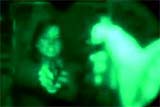 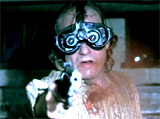 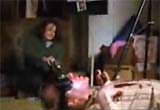 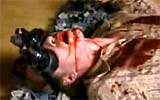 Killing of Serial Murderer Jamie Gumb (Buffalo Bill) in the Dark |
||||||||||||

|
Star Trek VI: The Undiscovered Country (1991) In this sixth film of the long-running sci-fi franchise, it was the "final voyage" for Capt. James T. Kirk and the Starship Enterprise, as the Federation engaged in battle with the Klingon Empire. The main villain was one-eyed, dastardly Klingon General Chang (Christopher Plummer), known for quoting Shakespeare. Chang had united in a conspiracy with Federation and Romulan dissidents to instigate war and disrupt peace talks. He was behind a deadly attack upon peace-keeping Klingon Chancellor Gorkon's (David Warner) ship Kronos One, and had supported the Chancellor's assassination by hired killers wearing Starfleet Federation suits and gravity boots. Chang had also fired from his own unseen cloaked, prototype Klingon Bird of Prey vessel beneath the Enterprise, to blamefully make it appear that the Enterprise was firing the two torpedoes. By the film's conclusion, he was threatening to destroy both the USS Enterprise and the USS Excelsoir (captained by Hikara Sulu (George Takei)). However, Vulcan Captain Spock (Leonard Nimoy) and Dr. Leonard "Bones" McCoy (DeForest Kelley) rigged a photon torpedo so it could locate Chang's invisible vessel (and its hot exhaust emissions) and make it a target. As the torpedo approached for impact, Chang spoke:
The explosion caused his cloaked location to be revealed. Afterwards, both Starfleet vessels opened fire, blasting it from two sides into oblivion. |
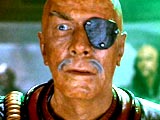 Klingon Chang: "To be or not to be" 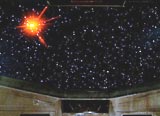 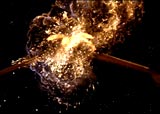 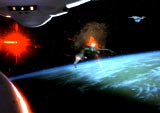
|
||||||||||||
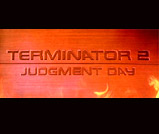
|
Terminator 2: Judgment Day (1991) Writer/director James Cameron's action-packed sequel was set around the year 1995. It starred Linda Hamilton as muscular warrior-female Sarah Connor, who had been institutionalized after attempting to blow up Cyberdyne Systems. She was having insane delusions and dreams about a nightmarish, end-of-the world cataclysmic event, that would occur in late August 1997 (in the future). She experienced the fiery effects of a nuclear holocaust on a children's playground. White light ignited everything like match heads as she saw her dream self burst into flames and her skin burned away. Los Angeles landmarks were pulverized as the shockwave of the blast hit the downtown area. The howling wind blasted apart the once-human figures of bone and ash. Sarah's own figure exploded down to skeletal remains. |
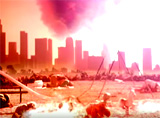  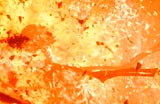 Cataclysmic Apocalypse |
||||||||||||

|
Terminator 2: Judgment Day (1991) The seemingly-indestructible prototype T-1000 android assassin (Robert Patrick) had been sent to Earth to kill young John Connor (Edward Furlong), the fatherless teen offspring of Sarah Connor. He was regarded as the child-savior of future humanity in a war with a deadly machine complex called SkyNet. The primary antagonist in the film, with its mimetic polyalloy (liquid metal) body had the uncanny ability to 'morph' into any solid shape, impersonate other persons and even camouflage himself with the background. In a startling death scene in a Reseda, California kitchen, the T-1000 mimicked the voice of John Connor's foster mother Janelle Voight (Jenette Goldstein) during a phone call with John, to learn his location. (During the call, John's voice was impersonated by the 'good' or protective Terminator T-800 (Arnold Schwarzenegger)). A clue that she was an imposter was given when she became irritated about her husband Todd's (Xander Berkeley) complaint about their dog Max's barking in the backyard - she jerked out her arm (off-screen) to shut him up. The Terminator T-800 tested her authenticity by asking about their dog (Max), using a fake dog name: "What's wrong with Wolfie?" - when she responded: "Wolfie's fine, honey. Wolfie's just fine," he sensed a trick. After the call was abruptly ended, the Terminator T-800 warned John: "Your foster parents are dead." The camera panned to the right, showing that Janelle's arm had elongated and become an elongated, bladed sword-like spike (similar in shape to the kitchen knife she was cutting with), impaling a milk carton container and Todd's head to the kitchen cabinet behind him. When she withdrew the arm, Todd's bloody body slumped to the floor. The android changed from Janelle's shape back into the cop disguise - the liquid metal re-shaped itself with a startling visual effect. |
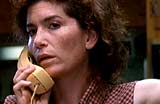 The T-1000 Impersonating Janelle and Her Voice 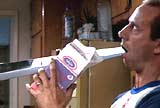 Impaled by Arm Shape-Shifted into Sword |
||||||||||||

|
Terminator 2: Judgment Day (1991) The severely-damaged Terminator T-800 (Arnold Schwarzenegger) ultimately terminated his seemingly-indestructible opponent android, the T-1000 Terminator (Robert Patrick) in the final action sequence in the steel foundry. He rose up behind Sarah Connor (Linda Hamilton) and her son John (Edward Furlong) on the chain drive behind them with an M-79 aimed at the T-1000. When they instinctively ducked, the grenade was launched into the belly of the creature. It exploded and ripped a gaping hole in the android, causing it to let out inhuman, screeching, inside-out screams. Losing its balance, it toppled over into the molten steel vat where it flopped around in its death throes, transforming itself into various mutations - Janelle (Jenette Goldstein) with her blade arm, the hospital security guard, and the chrome motorcycle cop. Unable to re-form itself in the extreme temperature of the liquid steel, it finally dissipated and dissolved into the fiery vat. |
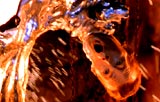 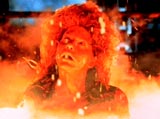 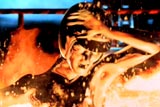 Death of T-1000 in Vat of Molten Steel |
||||||||||||

|
Terminator 2: Judgment Day (1991) # 43 In a sacrificial scene, after defeating the shape-shifting, metallic T-1000 android (Robert Patrick), the lovable anti-hero - the Terminator T-800 model (Arnold Schwarzenegger), decided to destroy his own CPU:
He explained to Sarah Connor (Linda Hamilton): "I cannot self-terminate. You must lower me into the steel." He said goodbye to tearful surrogate son John Connor (Edward Furlong):
They hugged each other, and the Terminator shook Sarah's hand and then he stepped out onto the chainfall and told both of them: "Goodbye." Slowly, the Terminator machine nobly and suicidally descended and sank into the steaming hot molten steel for the good of humankind. His metal hand was the last thing to disappear - it formed a "thumbs up" in the final seconds. The Terminator's TermoVision showed glitched read-outs and then collapsed to a bright red, solid line that turned off like a television set - it signaled his technological death. |
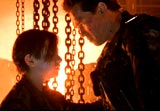 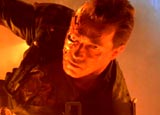 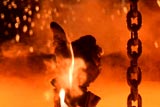 "Thumbs-Up" Goodbye from T-800 Terminator |
||||||||||||
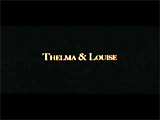
|
Thelma & Louise (1991) Director Ridley Scott's feminist road film followed the exploits of two female fugitives from the law, after taking matters into their own hands and murdering a rapist:
In the film's conclusion, the two vowed to keep fleeing in their 1966 Ford Thunderbird convertible, with the cops stationed behind them and the Grand Canyon's cliffside ahead of them:
They kissed each other, and then grasped hands as they met their fate, taking off in a swirl of dust. It was a soaring, freeze-frame, white-out finale ending as they drove into the Grand Canyon (and oblivion).
|
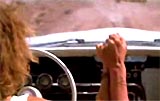  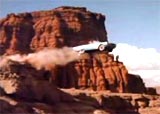 The Grand Canyon Flight to the Death |
||||||||||||
(chronological by film title) Intro | 1915-1929 | 1930-1933 | 1934-1938 | 1939 | 1940-1942 | 1943-1945 | 1946-1947 | 1948-1949 1950-1952 | 1953-1955 | 1956-1957 | 1958-1959 1960-1961 | 1962-1963 | 1964-1966 | 1967-1968 | 1969-1970 1971 | 1972 | 1973 | 1974 | 1975 | 1976 | 1977-1978 | 1979 1980 | 1981 | 1982 | 1983 | 1984 | 1985 | 1986 | 1987 | 1987 | 1988 | 1989 1990 | 1991 | 1992 | 1993 | 1994 | 1994 | 1995 | 1995 | 1996 | 1997 | 1998 | 1998 | 1999 2000-2001 | 2002 | 2003 | 2004 | 2005 | 2006 | 2007 | 2008 | 2009 | 2010 | 2011 |